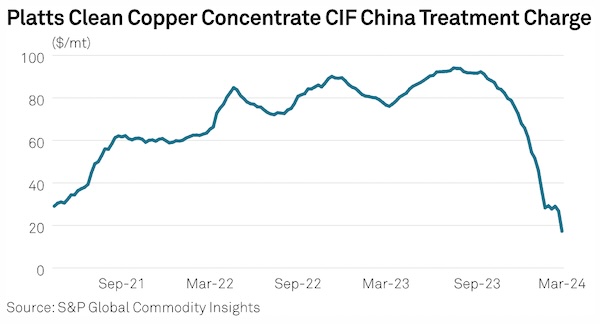China’s Zijin Mining set to start copper concentrate blending as trend shifts
Time:Wed, 06 Mar 2024 08:06:02 +0800
keywords :
Southern China-based Zijin Mining Group, the country’s top miner, plans to start operations at its copper concentrate blending facilities in China by the end of June, market sources told S&P Global Commodity Insights over the week of March 3, signaling a shift in blending capacity to regions that allow tax deferrals.
The facilities will have a processing capacity of 600,000 mt/year and will be set up in the coastal Dongfang city of Hainan province, the sources said.
The capacity of China’s copper concentrates blending at bonded areas has been increasing over the past few years since the country gave the green light to build blending facilities in zones at Fangchenggang and Yantai cities in November 2020, the sources said. These blending facilities account for about 50% of the world’s total copper blending output.
Bonded areas are exclusive zones designated by China’s customs authorities that allow tax deferrals on imported goods. Storage in these areas can help importers defer tax payments.
Total approved copper blending capacity in China is expected to reach 2.75 million mt this year, according to S&P Global Commodity Insights’ calculations based on company and source data.
In an earlier report, Zijin Mining said it mainly produces copper from Julong in Tibet, Timok in Serbia and Kamoa in Congo. Total production reached 877,317 mt in 2022 from Zijin Mining’s copper mines.
China’s custom authorities have strict requirements for impurity content related to the import of copper concentrates, mainly on arsenic, lead, fluorine, cadmium and mercury.
As such, trading companies were blending complex copper concentrates with impurity content exceeding requirements for clean copper concentrate, in a bid to sell to smelters that tend to compromise on quality.
The traditional blending business was dominated by western trading houses, and they were typically located in Malaysia, Taiwan, Korea, Mexico and Peru.
However, more Chinese smelters have been working on blending directly in bonded warehouses as blending volumes from traders experience a downtrend.
Copper miners typically blend copper concentrate or partially process copper ore with other concentrates to develop feedstock material that is supplied to smelters looking to produce refined copper.
Challenges to blending
Despite the narrowing spread of treatment and refining charges between clean and blended copper concentrates, trading companies remain unmotivated to pursue direct blending, preferring instead to sell complex and clean concentrates to smelters separately.

S&P Global observed transactions totaling 100,000 mt of blended copper concentrate over January-February, which accounted for only 10% of total transaction volumes during the same period.
High financing and freight costs, challenges in sourcing clean copper concentrates and a shortage of suitable blending materials impacted blenders’ profit margins.
The pressure on margins will become more obvious especially since Indonesia’s copper concentrate export ban is drawing near. This would eventually leave Asian blenders without suitable high fluorine copper concentrates needed for blending with copper concentrates of high arsenic content.
“It makes more sense for smelters to blend as they have more long-term contracts for standard clean and can save freight and insurance costs,” a trader explained.
At the same time, sellers of complex copper concentrate with high arsenic content found it challenging to find buyers, as the volume required for standard clean copper is greater, sources said.
The spread between standard clean and ex-Asia blended copper concentrates narrowed from $10/mt in 2023 to $3-$4/mt in February 2024, due to a shortage of copper concentrates, market sources said.
Traders believe Asia-origin blended copper concentrates can fetch a higher price than standard clean due to the shorter voyage, which reduces smelters’ financing costs and meet urgent demand.
Platts assessed CIF China Clean Copper Concentrates treatment and refining charges at $14.20/mt and 1.42 cents/lb, respectively, March 4, S&P Global data showed, which was the lowest since copper concentrates was first assessed on Feb. 1, 2021.
Source: Platts
